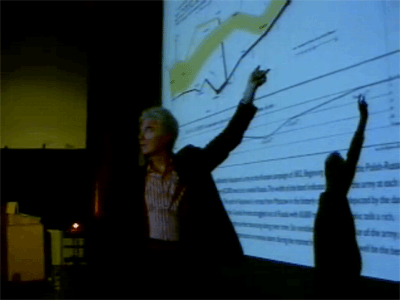David Byrne cracking himself up.
(Pictures captured off the webcast.)
I {heart} PowerPoint was presented with Byrne's usual wide-eyed
earnestness,
in a voice that admits that maybe the words might
mean something,
letting the audience decide what's funny
and what's serious.
The audience made some strange
decisions.

One of the slides had Whit Diffie in it.
Hi, Whit!

By way of introducing Tufte's fascination
with resolution and data-density, Byrne briefly
showed the Minard graph
Tufte frequently uses. The audience
didn't think it was so easy to understand.
Large parts of the talk were unspecific
to Byrne's work and just gave a
general history of
PowerPoint and the prevailing deliberate
and non-deliberate jokes, collected off
the Internet. The history was interesting, but
I don't like it when people who have
something to say think they have to entertain
as collectors.
But his treatment of Tufte's widely publicised
criticism wasn't just an echo.
Byrne points out that PowerPoint
is not a very verbal medium; that there's
communication going on that's easy to miss;
that the superficiality is a chance, not
just an obstacle.
David Byrne's own words come haltingly,
as if from great distance. Sometimes he can't
remember the right word and uses another
one instead (like using "Aphorism" for
"Acronym".) There were no notes.

The core thesis:
Powerpoint presentations are a form of theater,
the Brechtian / Japanese kind where a speaker off-screen
lends a voice to actors that do not pretend to be
anything but actors.
People are not seeing that yet, but maybe they will,
in a thousand years or so. |